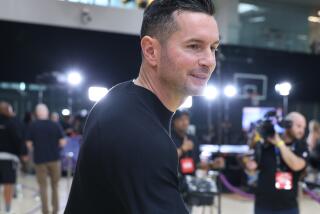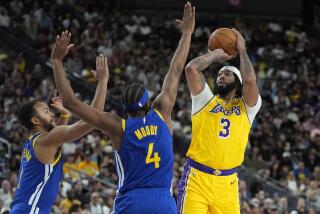Lakers’ offseason needs: Outside shooting
The first in a series analyzing the Lakers’ biggest offseason needs.
So many offseason uncertainties fill this roster. Will the Lakers hit a “home run,” as General Manager Mitch Kupchak hopes? Can Kobe Bryant continue to turn back the clock? Will the Lakers keep Andrew Bynum and see his on-court production trumping his poor behavior? Will the Lakers get anything of value for Pau Gasol or perhaps just feature him better in the offense? Will the Lakers find any pieces to produce a more consistent bench? Can the Lakers add youth to their roster? Can the Lakers manage to address these issues while also trimming payroll?
All of these issues will largely determine whether L.A. can truly contend for a championship next season. But there’s one issue that plays the biggest factor: whether the Lakers can improve their outside shooting. The team shot 39.5% from the field in 2011-12, which ranked 25th in the league. That number dropped to a 30% clip during the postseason, putting them in 11th place out of the 16 playoff teams. In the last five seasons, the Lakers have lacked consistent outside shooting, a variable they could no longer disguise in the past two seasons.
Considering the Lakers’ aging roster, the team can’t afford such a poor performance from three-point range in the 2012-2013 season.
That’s not to say the outside shooting was entirely bad. Andrew Goudelock earned himself time in the rotation mainly because he could hit the three-point dagger. Ramon Sessions’ 44.3% mark from downtown represented his highest shooting percentage from three-point range in his five-year career. Troy Murphy’s 41.8% clip from outside in the regular season played a large part in helping Andrew Bynum play through double teams. Steve Blake’s strong marksmanship in Games 1, 4 and 7 in the first-round series against the Denver Nuggets played a large part in those wins.
But those examples actually provided stark reminders on how fleeting the Lakers’ success from outside became.
Goudelock still averaged only a 37.8% mark from downtown and didn’t play much late in the season because his poor defense and poor ball handling offset his offense. Sessions totally disappeared in the playoffs both in marksmanship (37.7%) and tentativeness. Mike Brown’s coaching staff noticed that Murphy’s low arc in his shot and limited athleticism contributed to his streaky accuracy. Plenty of Laker fans focused on Blake missing a wide-open three pointer in what could’ve been the game-winner in the team’s Game 2 loss to Oklahaoma City in the second round. But oftentimes Brown and his staff and Laker teammates fretted that Blake usually looked tentative in even taking those open shots.
And then let’s not forget about Metta World Peace and Matt Barnes. Mostly, the Staples Center crowd gasped whenever World Peace hoisted three-pointers (29.6%). Once the playoffs started, Barnes couldn’t hit an outside shot (27.1%) no matter how many hours he spent in the gym. Not even Kobe Bryant could solve this issue after hitting only 30.3% of his three-point shots.
The most obvious conclusion involves the Lakers devoting the mini mid-level exception ($3 million) or the $8.9-million trade exception on acquiring a more consistent outside shooter. The Lakers, as reported by The Times’ Mike Bresnahan, are interested in Warriors small forward Brandon Rush, who shot 45% from downtown with Golden State last season. Courtney Lee, of the Houston Rockets, consistently shoots 40% from three-point range. But it remains to be seen whether the Lakers could afford such players.
That’s where it’s possible the Lakers would have to somehow upgrade their outside shooting from within.
One NBA coach told me a few years ago that stepping one or two feet closer to the basket after catching the ball offers the best way to overcome a shooting slump. But that doesn’t apply with the Lakers. According to Hoopdata.com, the Lakers shot 40.7% from shots within 10-15 feet and 39.3% from shots within 16-23 feet.
The mechanical issues with World Peace and Troy Murphy are glaringly obvious. But given that the Lakers aren’t expected to keep Murphy, that only leaves World Peace who needs serious tinkering with his shot. It’s safe to say the Lakers’ coaching staff will point out various nuances among the other shooters, but there’s nothing too noticeable. The most correctable part instead reflects how the Lakers generated their three-point shots.
According to Synergy Sports Technlogy, the Lakers took 777 of their 1,328 three-point attempts off spot-up shots and hit 32.8% of them. They went 38-of-124 (30.6%) from downtown after running in transition. And they finished 52-of-177 (29.4%) from behind the arc off isolation plays. Meanwhile, the Lakers showed some strong marksmanship when they ran the pick-and-roll. The ball handler hit 41.2% of those shots, while the roll man made 47.8% of his attempts. Yet the Lakers manufactured few opportunities with the ball handler (85) and roll man (23) relative to their attempts in other areas.
It’s understandable for the team to take spot-up jumpers. That happens when they command double teams in the post. But those sequences often either showed the Lakers’ ball movement becoming stagnant, the perimeter shooters showing hesitancy in taking open shots, or both. In most cases, firing off a three-pointer in transition amounts to nothing more than a wasted possession. And simply running an offense through isolation appears too predictable and inefficient. Simply put, the Lakers’ outside shooting would improve if they ran the sets leading into the shot a lot better. In turn, that would make it easier for the Lakers’ threats in Bryant, Gasol and Bynum to become even more profound.
Who knows if upgrading the roster, players altering their shooting strokes and the coaching staff changing their offensive sets would significantly mitigate this problem. The Lakers have talked openly in previous seasons about addressing these issues, to no avail. Yet the Lakers have no other choice but to try. They can no longer hope for their size advantage, talent and experience to gloss over the poor outside shooting.
Lakers’ outlook on Dwight Howard should change
Email the Lakers blog at mgmedin@gmail.com. Follow the Lakers blog on Twitter.
More to Read
All things Lakers, all the time.
Get all the Lakers news you need in Dan Woike's weekly newsletter.
You may occasionally receive promotional content from the Los Angeles Times.







